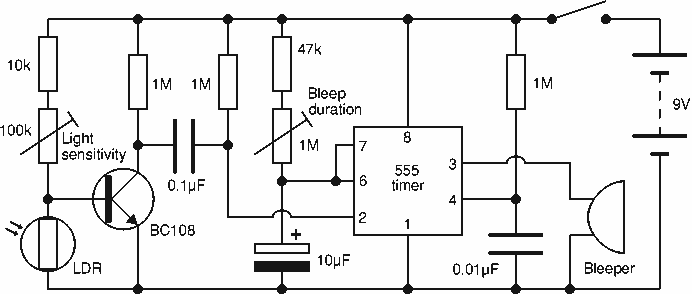
Stun Gun Circuit

The circuit detects a sudden shadow falling on the light-sensor and sounds the bleeper when this happens. The circuit will not respond to gradual changes in brightness to avoid false alarms. The bleeper sounds for only a short time to prevent the battery running flat. Normal lighting can be used, but the circuit will work best if a beam of light is arranged to fall on the light-sensor. Breaking this beam will then cause the bleeper to sound.
The circuit operates based on a light-dependent resistor (LDR) or phototransistor configured as a light sensor. This sensor is sensitive to abrupt changes in light intensity, allowing it to detect when a shadow is cast over it. The circuit includes a comparator, which compares the voltage across the light sensor with a predetermined threshold voltage. When a sudden shadow is detected, the voltage drop across the sensor triggers the comparator, which then activates a sound-generating component, referred to as a bleeper or buzzer.
To mitigate false alarms caused by gradual changes in ambient light, the circuit incorporates a time delay mechanism. This can be achieved using a capacitor and resistor in a timing circuit that ensures the comparator only triggers the bleeper if the shadow persists for a brief moment. The duration of the bleeper's sound is controlled by an additional timing circuit, which can also be composed of a capacitor and resistor, ensuring that the sound is emitted for a short, predefined interval.
Power management is crucial for this circuit, particularly to prolong battery life. The circuit may include a low-power operational amplifier for the comparator and a low-current bleeper to minimize power consumption. Additionally, if the circuit is designed to be used in environments with varying light conditions, it may feature an adjustable potentiometer to calibrate the sensitivity of the light sensor.
Overall, this circuit is ideal for applications that require a simple and effective method for detecting interruptions in a light beam, such as security systems or alert mechanisms in various settings. Proper layout and component selection will ensure reliability and efficiency in operation.The circuit detects a sudden shadow falling on the light-sensor and sounds the bleeper when this happens. The circuit will not respond to gradual changes in brightness to avoid false alarms. The bleeper sounds for only a short time to prevent the battery running flat. Normal lighting can be used, but the circuit will work best if a beam of light is arranged to fall on the light-sensor.
Breaking this beam will then cause the bleeper to sound. 🔗 External reference
The circuit operates based on a light-dependent resistor (LDR) or phototransistor configured as a light sensor. This sensor is sensitive to abrupt changes in light intensity, allowing it to detect when a shadow is cast over it. The circuit includes a comparator, which compares the voltage across the light sensor with a predetermined threshold voltage. When a sudden shadow is detected, the voltage drop across the sensor triggers the comparator, which then activates a sound-generating component, referred to as a bleeper or buzzer.
To mitigate false alarms caused by gradual changes in ambient light, the circuit incorporates a time delay mechanism. This can be achieved using a capacitor and resistor in a timing circuit that ensures the comparator only triggers the bleeper if the shadow persists for a brief moment. The duration of the bleeper's sound is controlled by an additional timing circuit, which can also be composed of a capacitor and resistor, ensuring that the sound is emitted for a short, predefined interval.
Power management is crucial for this circuit, particularly to prolong battery life. The circuit may include a low-power operational amplifier for the comparator and a low-current bleeper to minimize power consumption. Additionally, if the circuit is designed to be used in environments with varying light conditions, it may feature an adjustable potentiometer to calibrate the sensitivity of the light sensor.
Overall, this circuit is ideal for applications that require a simple and effective method for detecting interruptions in a light beam, such as security systems or alert mechanisms in various settings. Proper layout and component selection will ensure reliability and efficiency in operation.The circuit detects a sudden shadow falling on the light-sensor and sounds the bleeper when this happens. The circuit will not respond to gradual changes in brightness to avoid false alarms. The bleeper sounds for only a short time to prevent the battery running flat. Normal lighting can be used, but the circuit will work best if a beam of light is arranged to fall on the light-sensor.
Breaking this beam will then cause the bleeper to sound. 🔗 External reference





